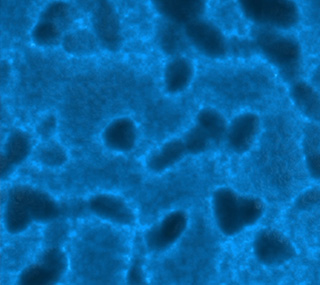Parathyroid disease
The body has four parathyroid glands — tiny structures about the size of a grain of rice — located in the neck near the thyroid gland.
Parathyroid glands control your calcium, like a thermostat controls the temperature in your house. If your house is 90 °F, then the thermostat should turn "off" the heater. If the heater is still "on," then your thermostat is broken. Similarly, your parathyroid glands control calcium levels in your blood. If your serum calcium is high, then your parathyroid glands should be "turned off" (i.e., your parathyroid hormone (PTH) should be low). If your serum calcium is high and your parathyroid glands are making lots of PTH, then one or more parathyroid glands are not working correctly. Doctors call this condition primary hyperparathyroidism. Most people with primary hyperparathyroidism have a parathyroid adenoma, which is a benign, enlarged parathyroid gland.
People with kidney problems can have problems with their parathyroid glands also. In these cases all four parathyroid glands grow and calcium levels can be high or low. This is called secondary or tertiary hyperparathyroidism, depending on the calcium levels.
 Primary hyperparathyroidism is a diagnosis made by showing an increased blood calcium level in coordination with a high blood parathyroid hormone level.
Primary hyperparathyroidism is a diagnosis made by showing an increased blood calcium level in coordination with a high blood parathyroid hormone level.
Sources: National Cancer Institute, American Association of Endocrine Surgeons and UC Davis Comprehensive Cancer Center
Patients with primary hyperparathyroidism may have the following:
- Pain in the abdomen, side, or back that doesn't go away
- Pain in the bones, or a broken bone
- Weakness
- Feeling very tired
- Nausea and vomiting
- Loss of appetite
- Weight loss for no known reason
- Being much more thirsty than usual
- Urinating much more than usual
- Constipation
- Trouble thinking clearly
Sources: National Cancer Institute, American Association of Endocrine Surgeons and UC Davis Comprehensive Cancer Center
There are few risk factors for parathyroid disease. There are some rare inheritable disorders that increase one’s risk. Treatment with radiation therapy for another condition may also increase the risk of developing a parathyroid adenoma. People with kidney problems also can develop problems with their parathyroid glands.
Most people with parathyroid problems have a benign tumor called an adenoma. Very few patients may have a parathyroid cancer; the incidence of parathyroid cancer is almost 1 in 2 million. Cases of parathyroid cancer make up less than 1 percent of the total number of patients with primary hyperparathyroidism. Patients are usually older than 30 and have very high calcium levels.
Sources: National Cancer Institute, American Association of Endocrine Surgeons and UC Davis Comprehensive Cancer Center
Primary hyperparathyroidism is treated by surgery. Specific surgical techniques for parathyroid tumors can include:
- Minimally invasive parathyroidectomy: This phrase is used to encompass a range of different procedures that strive to minimize the length of the surgical incision, thereby facilitating a quicker recovery and better cosmesis (appearance). For decades we made an incision to look at all four parathyroid glands. Now, we use imaging studies (such as ultrasound) to focus the operation and remove just the one enlarged parathyroid gland that is causing the problem. Typically the incision is about 2.5 cm (about 1 inch).
- Four-gland parathyroid exploration: A type of surgery in which all glands are visually evaluated and the abnormal appearing one(s) removed.
- Subtotal parathyroidectomy: This procedure removes three parathyroid glands and part of a fourth. Sometimes, all four glands will be removed and part of the smallest gland will be autotransplanted.
- Parathyroid autotransplantation: The parathyroid tissue in the neck is removed, and a small amount transplanted into either the forearm or the neck – an easily accessible location on the body for continuing medical evaluation or procedures. This procedure is typically performed for patients in whom all four parathyroid glands are affected.
- Intra-operative parathyroid hormone monitoring: People with overactive parathyroid glands produce parathyroid hormone (PTH) in large amounts. This can be detected in the blood. Your surgeon can use this test to be sure all abnormal glands have been removed. Prior to surgery, your blood PTH will be checked. It should be high. Once your surgeon has located the abnormal gland and removed it, your surgeon will check your blood PTH again. The level should have dropped by 50 percent of baseline and be within normal range within 10 minutes. If it is, then no further surgery needs to be done. If it is not, then your surgeon will look for additional abnormal parathyroid glands. (See: Four-gland parathyroid exploration).
- Parathyroid cryopreservation: Patients with certain genetic conditions or prior neck surgery may be at risk for having too little parathyroid hormone following parathyroidectomy. For these patients a piece of parathyroid can be saved in a freezer for a later autotransplantation (see above).
After the operation, your surgeon will follow you with routine calcium levels to check for any recurrence (if it comes back). The risk of recurrent parathyroid problems following surgery is low.
More about surgical interventions for primary hyperparathyroidism cancer
Sources: National Cancer Institute, American Association of Endocrine Surgeons and UC Davis Comprehensive Cancer Center
Surgical Oncology and Endocrine Surgery
 Michael Campbell, M.D.
Michael Campbell, M.D.
Associate Professor of Surgery
 Claire Graves, M.D.
Claire Graves, M.D.
Assistant Professor of Surgery
Otolaryngology / Head and Neck Surgery
 Marianne Abouyared, M.D.
Marianne Abouyared, M.D.
Assistant Professor of Otolaryngology
Head and Neck Oncology and Microvascular Surgery
 Arnaud F. Bewley, M.D.
Arnaud F. Bewley, M.D.
Assistant Professor of Otolaryngology
Head and Neck Oncology and Microvascular Surgery
 Andrew Birkeland, M.D.
Andrew Birkeland, M.D.
Assistant Professor of Otolaryngology
Head and Neck Oncology and Microvascular Surgery
 Scott Fuller, M.D., M.Sc.
Scott Fuller, M.D., M.Sc.
Assistant Professor of Otolaryngology
Neurological Surgery
 Orwa Aboud, M.D., Ph.D.
Orwa Aboud, M.D., Ph.D.
Assistant Professor of Neurological Surgery
 Orin Bloch, M.D., FAANS
Orin Bloch, M.D., FAANS
Associate Professor of Neurological Surgery
 Kiarash Shahlaie, M.D., Ph.D., FAANS
Kiarash Shahlaie, M.D., Ph.D., FAANS
Associate Professor of Neurological Surgery
Hematology and Oncology
 Jonathan Riess, M.D., M.S.
Jonathan Riess, M.D., M.S.
Associate Professor of Internal Medicine, Hematology and Oncology
Dietitians
 Danielle Baham, M.S., R.D.
Danielle Baham, M.S., R.D.
 Kathleen Newman, R.D., C.S.O.
Kathleen Newman, R.D., C.S.O.
Genetic Counselors
Social Work
 Sarah Conning, L.C.S.W., O.S.W.-C.
Sarah Conning, L.C.S.W., O.S.W.-C.





 Nicole Mans, M.S., L.C.G.C.
Nicole Mans, M.S., L.C.G.C. Jeanna Welborn, M.D.
Jeanna Welborn, M.D.